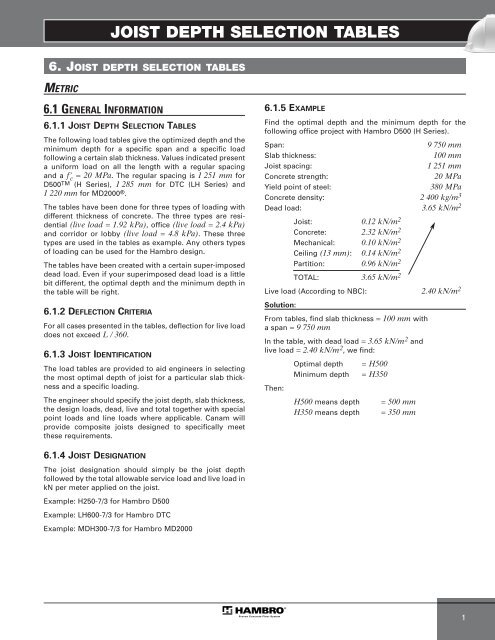MEP-Technical Manual CDN 0408.qxd - Hambro
MEP-Technical Manual CDN 0408.qxd - Hambro
MEP-Technical Manual CDN 0408.qxd - Hambro
Create successful ePaper yourself
Turn your PDF publications into a flip-book with our unique Google optimized e-Paper software.
JOIST DEPTH SELECTION TABLES<br />
6. JOIST DEPTH SELECTION TABLES<br />
METRIC<br />
6.1 GENERAL INFORMATION<br />
6.1.1 JOIST DEPTH SELECTION TABLES<br />
The following load tables give the optimized depth and the<br />
minimum depth for a specific span and a specific load<br />
following a certain slab thickness. Values indicated present<br />
a uniform load on all the length with a regular spacing<br />
and a f’ c = 20 MPa. The regular spacing is 1 251 mm for<br />
D500TM (H Series), 1 285 mm for DTC (LH Series) and<br />
1 220 mm for MD2000 ®.<br />
The tables have been done for three types of loading with<br />
different thickness of concrete. The three types are residential<br />
(live load = 1.92 kPa), office (live load = 2.4 kPa)<br />
and corridor or lobby (live load = 4.8 kPa). These three<br />
types are used in the tables as example. Any others types<br />
of loading can be used for the <strong>Hambro</strong> design.<br />
The tables have been created with a certain super-imposed<br />
dead load. Even if your superimposed dead load is a little<br />
bit different, the optimal depth and the minimum depth in<br />
the table will be right.<br />
6.1.2 DEFLECTION CRITERIA<br />
For all cases presented in the tables, deflection for live load<br />
does not exceed L / 360.<br />
6.1.3 JOIST IDENTIFICATION<br />
The load tables are provided to aid engineers in selecting<br />
the most optimal depth of joist for a particular slab thickness<br />
and a specific loading.<br />
The engineer should specify the joist depth, slab thickness,<br />
the design loads, dead, live and total together with special<br />
point loads and line loads where applicable. Canam will<br />
provide composite joists designed to specifically meet<br />
these requirements.<br />
6.1.4 JOIST DESIGNATION<br />
The joist designation should simply be the joist depth<br />
followed by the total allowable service load and live load in<br />
kN per meter applied on the joist.<br />
Example: H250-7/3 for <strong>Hambro</strong> D500<br />
Example: LH600-7/3 for <strong>Hambro</strong> DTC<br />
Example: MDH300-7/3 for <strong>Hambro</strong> MD2000<br />
6.1.5 EXAMPLE<br />
Find the optimal depth and the minimum depth for the<br />
following office project with <strong>Hambro</strong> D500 (H Series).<br />
Span: 9 750 mm<br />
Slab thickness: 100 mm<br />
Joist spacing: 1 251 mm<br />
Concrete strength: 20 MPa<br />
Yield point of steel: 380 MPa<br />
Concrete density: 2 400 kg/m3 Dead load: 3.65 kN/m2 Joist: 0.12 kN/m2 Concrete: 2.32 kN/m2 Mechanical: 0.10 kN/m2 Ceiling (13 mm): 0.14 kN/m2 Partition: 0.96 kN/m2 TOTAL: 3.65 kN/m2 Live load (According to NBC): 2.40 kN/m2 Solution:<br />
From tables, find slab thickness = 100 mm with<br />
a span = 9 750 mm<br />
In the table, with dead load = 3.65 kN/m2 and<br />
live load = 2.40 kN/m2 , we find:<br />
Optimal depth = H500<br />
Minimum depth = H350<br />
Then:<br />
H500 means depth = 500 mm<br />
H350 means depth = 350 mm<br />
1



